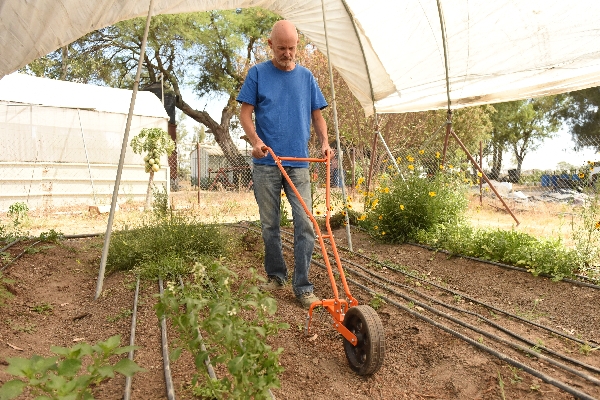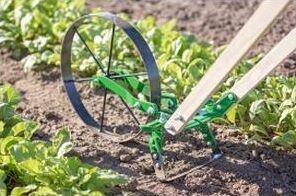Is a Wheel Hoe Worth it?
Author: Greg Baka
The answer is definitely Yes! A wheel hoe is a gardening tool that has an implement (like a hoe blade or cultivator teeth) mounted to a hand-pushed machine with one or two wheels in front of the frame and a set of handles angled up from the rear of the frame. It is used for weeding and cultivating soil in vegetable gardens, hoop houses, and on small farms. It can also make furrows, hill crops, and loosen compacted soil. A wheel hoe is lightweight, versatile, and maneuverable. There are a few different types of wheel hoes with a wide range of attachments for different tasks. It can save you a lot time, energy, and money.
Also see our Wheel Hoe FAQ page for answers to a wider variety of questions.

So is a wheel hoe worth the money?
The price range for a wheel hoe depends on the brand, model, and attachments. According to web resources, a wheel hoe can cost anywhere from $200 to $700.
A wheel hoe replaces some of the tasks done with both a garden hoe and a rototiller. The garden hoe tasks include weeding and hilling. The rototiller tasks are cultivating and loosening the soil.
Comparison to a Garden Hoe for Weeding
To determine if a wheel hoe is worth it, we need to compare the time and effort it takes to weed and hill with a hoe versus a wheel hoe. There are no official studies, but from reading gardening blogs and other wheel hoe sites, the common claim is for twice to ten times faster weeding!
Time Savings
"Yes indeed, such a wheel hoe is the ideal tool for keeping weeds under control in any serious home or market garden. Properly used, the wheel hoe with a stirrup blade will cultivate soil and hoe weeds ten times faster than a hand hoe." Source

"Anyway, if you have a sizable garden, the wheel hoe can speed up hoeing by two to three times faster. It is basically like a block plane in carpentry, gliding along and cutting a thin layer off the top of the soil." Source
Effort and Energy Savings
When keeping your garden or small farm weed free, any reduction in effort makes the chore much more pleasant. And if it is easier then it is much more likely that you will do it regularly and stay ahead of the weeds. Which then makes it even easier yet because the weeds are always small and sparse.
"...the most efficient implement yet designed for extensive garden cultivation." Eliot Coleman, author of "The New Organic Gardener - A Master’s Manual of Tools and Techniques for the Home and Market Gardener" Source
"It is easily the most time-saving, back-sparing tool in my shed, as it deals with the most taxing job: removing weeds, especially ones in compacted soil." Source
"Although it is a bit of work to get through the soil (since we have some rather clumpy soil still), it is tremendously easier than bending over to pull up all of the weeds. My back isn't in the best shape so I appreciate this very much." Source
Comparison to a Garden Hoe for Hilling
Hilling requires you to move soil from the path up and into the row of crops to smother small weeds and add a little additional soil support to the base of your crop plants. Traditionally you would use a draw hoe, pulling from each side of the row towards the center. Hilling with a draw hoe requires lots of repetitive motion using your arms and shoulders to manipulate the soil to the correct position next to and between your plants.

Rototiller and Wheel Hoe Operation Comparison
A big-ticket gardening machine that you may consider buying is a rototiller. Rototillers are designed for one job - breaking and churning the soil by cutting small slices of soil and stirring them together as you walk the machine forward. You can use a rototiller to break and churn hard-packed soil 4 to 8 inches deep, or to stir compost and amendments into existing garden spaces.

The effort needed to use a wheel hoe and a rototiller is also quite different. Even though a rototiller is usually self-propelled, it is still many times heavier and controlling the forward path takes lots of shoulder and arm strength.
There is also a big difference in keeping a rototiller in a “ready to go” state compared to the wheel hoe. The rototiller will need regular engine maintenance and fuel.
Also see this other article's in-depth comparison of using a wheel hoe versus a Grillo 22 inch Rear Tine Tiller.
Yearly Cost Comparison of a Tiller and a Wheel Hoe
Four basic types of Rototillers are marketed for gardens; the cultivator, the front tine tiller, the mid-tine tiller, and the rear tine tiller. They range in price from $100 to $6,000. Most home models that you will find at your local home improvement store are in the $400 to $1,000 range. Source#1 Source#2
Let us start by comparing the life span of a rototiller to a wheel hoe. According to an academic study from the Journal of Food, Agriculture & Environment (2008 Vol.6) "The power tiller has an average lifespan of 4-5 years depending on how it is used and handled." Whereas most wheel hoes are considered a "lifetime" purchase that will last 20+ years.
To compare the lifetime cost of the wheel hoe versus the rototiller, let's assume an average $700 rototiller versus a $400 wheel hoe complete with multiple attachments. If the tiller has a 5 year life span, then the yearly cost is $700/5 = $140, not including any fuel or maintenance. If the wheel hoe has a life span of 20 years, then the yearly cost of the wheel hoe is $400/20 = $20, with no fuel and minimal maintenance needed. The $120 a year savings would provide a gardener with a lot of seeds and compost!
Most gardening and small farm experts recommend that unless you have a very large commercial garden, you will be better off renting a rototiller for those special occasions when you need to stir your soil deeply or are breaking in a new garden plot. "The average cost to rent a tiller or rototiller for a day is approximately $77, with size being the largest factor. The cost ranges between $36-$150 dollars per day based on the size." Source
Summary
So is a Wheel Hoe worth it? The answer is definitely Yes! For a reasonable investment, you get a tool that weeds, hills, and cultivates in less time, with less effort, and does so for a low annual cost.

Author: Greg Baka is the founder of EasyDigging.com
He is also an experienced gardener and home remodeling DIY'er. He has tackled everything from underground drainage to metal roofing, and all things in between. Using his engineering degree, he designed a variety of construction and excavating equipment.
Check out our Gardening and Digging Tools!
EasyDigging.com sells a variety of heavy-duty tools for gardening, landscaping, construction, and small-scale agriculture.
Just click one of the product types in the green menu above...▲
Check out our Gardening and Digging Tools!
EasyDigging.com sells a variety of heavy-duty tools for gardening, landscaping, construction, and small-scale agriculture.
Just click HERE to shoot back up to the top of the page, then open the "Product Menu" in the big green bar.
